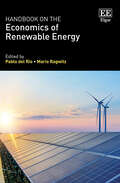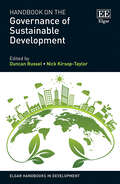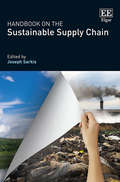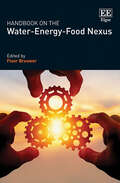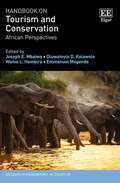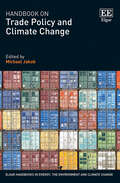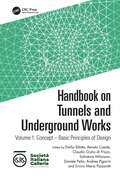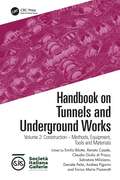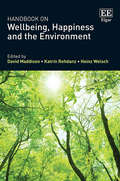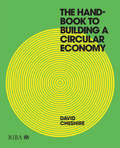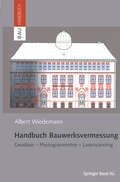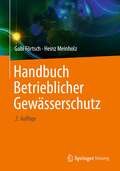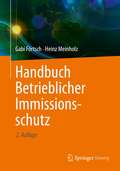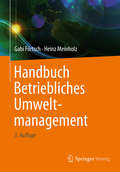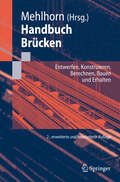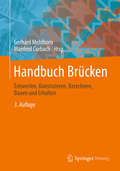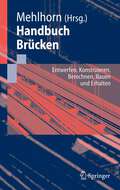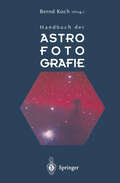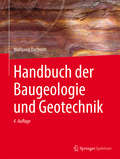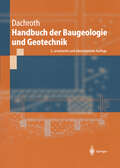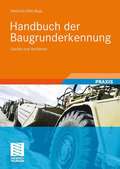- Table View
- List View
Handbook on the Economics of Renewable Energy
Renewable energy technologies produce many measurable benefits, such as a clear reduction in greenhouse gas emissions. However, it is also apparent that these methods of energy production come with costs. Discussing renewable energy developments within an economic context, this pertinent Handbook provides a comprehensive view of the present and future dimensions of renewable energy use.Divided into six authoritative parts, the Handbook employs economic evaluation to provide an analysis of the benefits and costs of renewable energy, allowing authors to extrapolate potential policy changes. Chapters address the conceptual, methodological and empirical dimensions of renewable energy, providing a broad coverage of key topics while maintaining a clear policy-oriented philosophy.With a structured application of energy economics to renewable energy issues, this enlightening Handbook will be beneficial for environmental and energy policy makers. It will also be an interesting read for academics within such fields as policy regulation, energy economics and environmental economics.
Handbook on the Governance of Sustainable Development (Elgar Handbooks in Development)
This Handbook brings together state-of-the-art contributions and international insights outlining the key theoretical developments and empirical findings related to sustainable development and governance. Providing both an overview and deep dive into the topic, it demonstrates how the concept of sustainable development and governance has led to multiple responses in both the academic and policy world from a theoretical, conceptual and operational viewpoint.Drawing on a wide range of perspectives, leading contributors examine global research on the governance of sustainable development, spanning disciplines including politics, public policy, international relations, environmental science and human geography. Providing an in-depth examination of current ongoing challenges such as climate change, trade and poverty, the Handbook investigates both collaborative approaches for sustainable development governance and policy innovation and integration. Furthermore, chapters utilise global case studies in action, exploring governance by international and non-government organisations and illustrating their key findings.Providing an interdisciplinary perspective, this Handbook will be a critical resource for research students of sustainable development and environmental governance as well as established researchers in the field. Scholars of politics and public policy will find the case studies informative and illuminating.
Handbook on the Sustainable Supply Chain (Research Handbooks in Business and Management series)
by Joseph SarkisSupply chain management has long been a feature of industry and commerce but, with increasing demands from consumers, producers are spending more time and money investing in ways to make supply chains more sustainable. This exemplary Handbook provides readers with a comprehensive overview of current research on sustainable supply chain management. Multi-disciplinary in scope, the Handbook includes contributions from over 70 expert authors from a variety of areas including management, engineering, accounting, policy studies, innovation, and marketing. Chapters analyze the three core areas of sustainable supply chain management: environmental, economic, and social. The Handbook explores broad themes such as globalization and general organization strategies as well as examining more specific topics including particular industries, social and regulatory dimensions, and technological advances. Scholars and advanced business and management students will greatly benefit from the depth of analysis in this Handbook as well as the suggestions for directions for future research and practice. Written in an accessible style, it is also ideal for practitioners and government agencies seeking solutions to practical issues regarding sustainable supply chain management.
Handbook on the Water-Energy-Food Nexus
This Handbook provides a comprehensive overview of how water, energy and food are interconnected, comprising a coherent system: the nexus. It considers the interlinkages between natural resources, governance processes seeking coherence among water, energy and food policies, and the adoption of transdisciplinary approaches in the field.With contributions covering a broad range of disciplinary perspectives and cross-cutting themes, the Handbook has a well-balanced mix of conceptual chapters and empirical studies. It includes a state-of-the-art analysis of the concepts and experiences in implementing the nexus in different policy environments, providing examples of successful integrated decision-making across the domains of water, energy and food. Offering a global perspective on water, energy and food security, the Handbook contains insights into achieving both national development goals and the Sustainable Development Goals. Chapters further highlight how to understand the concepts of the nexus in practice, impacts of the nexus in governance, policy and business, and methods and tools to strengthen the nexus.Interdisciplinary and thorough, this Handbook will be critical reading for environmental management, public policy and human geography scholars. It will also be a useful tool for policymakers looking for successful examples of policy coherence towards an integrated management of water, energy and food resources.
Handbook on Tourism and Behaviour Change (Research Handbooks in Tourism series)
A must-read for researchers and practitioners focusing on how the tourism industry needs to evolve given the societal and sustainability challenges we face, this comprehensive Handbook serves as a vital reference point for advanced research in tourism and behaviour change. Chapters depict critical reviews and debates on the topic, comprising both theoretical and empirical research illustrated by international case studies to explore strategies for current and future challenges in the field.The Handbook explores why, while there is heightened debate surrounding the negative impacts of tourism, people tend to be psychologically distant from this problem when they travel, and greater efforts need to be made to encourage people to be socially and environmentally responsible. Leading contributors from across the globe show how and why tourists’ and residents’ behaviour change interventions need to be designed to align with the Sustainable Development Goals going forward, and how a thorough understanding of tourism settings is key to achieving desired behaviour change outcomes.With the COVID-19 pandemic encouraging a resurgence of interest in the topic, this timely Handbook will be a key resource for tourism scholars and students. The explorations of why behaviour change is important and when to implement interventions that are offered across the chapters will also be beneficial to tourism practitioners and policy makers.
Handbook on Tourism and Conservation: African Perspectives (Research Handbooks in Tourism series)
The Handbook on Tourism and Conservation demonstrates the intrinsic nexus between tourism, the environment and sustainable natural resources use. It applies Ostrom’s social-ecological systems (SESs) theory as the analytical framework for reaching a consensus on divergent viewpoints within the context of global environmental change and emerging governance issues.Reflecting the interdependency between tourism and biodiversity conservation, the book focuses on four thematic areas. These include tourism and conservation in protected areas; tourism and climate change; sustainable agritourism; and destination communities and natural resources conservation. Thus equity and environmental justice issues are highlighted in relation to how destination communities have benefitted from tourism activities. The Handbook will be a useful guide for policymakers and relevant institutions in the implementation of tourism policies that balance issues in tourism and environmental conservation equally and which in turn could enhance wider participation in tourism development by all stakeholders in the sector.The Handbook will be a valuable resource for academics, researchers and students of tourism studies, geography, environmental policy, management and related fields. It will also be beneficial for sustainable tourism policymakers and planners.
Handbook on Trade Policy and Climate Change (Elgar Handbooks in Energy, the Environment and Climate Change)
This insightful Handbook provides a comprehensive overview of the most recent developments in the academic debate on the numerous and complex linkages between international trade and climate change. Adopting a broad interdisciplinary approach, it brings together perspectives from scholars in economics, political science and legal studies to confront the critical environmental challenges posed by globalization. Initial chapters provide an overview of the key debates related to international trade and climate policy, engaging with empirical data from the US and China to assess the impact of new trade initiatives and policy on greenhouse gas emissions, carbon leakage and the increase of trade in carbon-intensive products. Contributors propose policy options that align international trade with climate change mitigation and address crucial legal and practical implications, including the implementation of Border Carbon Adjustments and international trade disputes. Offering critical and empirically-based perspectives on the future of international trade policy, this timely Handbook is crucial reading for scholars, researchers and graduate students in political science, public policy and climate research. Policymakers will also benefit from its unique and insightful policy recommendations.
Handbook on Tunnels and Underground Works: Volume 1: Concept – Basic Principles of Design
by Emilio BilottaThe book provides a new, global, updated, thorough, clear and practical risk-based approach to tunnelling design and construction methods, and discusses detailed examples of solutions applied to relevant case histories. It is organized in three sequential and integrated volumes: Volume 1: Concept – Basic Principles of Design Volume 2: Construction – Methods, Equipment, Tools and Materials Volume 3: Case Histories and Best Practices The book covers all aspects of tunnelling, giving useful and practical information about design (Volume 1), construction (Volume 2) and best practices (Volume 3). It provides the following features and benefits: updated vision on tunnelling design, tools, materials and construction balanced mix of theory, technology and applied experience different and harmonized points of view from academics, professionals and contractors easy consultation in the form of a handbook risk-oriented approach to tunnelling problems. The tunnelling industry is amazingly widespread and increasingly important all over the world, particularly in developing countries. The possible audience of the book are engineers, geologists, designers, constructors, providers, contractors, public and private customers, and, in general, technicians involved in the tunnelling and underground works industry. It is also a suitable source of information for industry professionals, senior undergraduate and graduate students, researchers and academics.
Handbook on Tunnels and Underground Works: Volume 2: Construction – Methods, Equipment, Tools and Materials
by Emilio Bilotta Renato Casale Claudio Giulio di Prisco Salvatore Miliziano Daniele Peila Andrea Pigorini Enrico Maria PizzarottiThis book set provides a new, global, updated, thorough, clear, and practical risk-based approach to tunnelling design and construction methods, and discusses detailed examples of solutions applied to relevant case histories. It is organized in three sequential and integrated volumes: Volume 1: Concept – Basic Principles of Design Volume 2: Construction – Methods, Equipment, Tools and Materials Volume 3: Case Histories and Best Practices The book covers all aspects of tunnelling, giving useful and practical information about design (Vol. 1), construction (Vol. 2), and best practices (Vol. 3). It provides the following features and benefits: updated vision on tunnelling design, tools, materials, and construction balanced mix of theory, technology, and applied experience different and harmonized points of view from academics, professionals, and contractors easy consultation in the form of a handbook risk-oriented approach to tunnelling problems. The tunnelling industry is amazingly widespread and increasingly important all over the world, particularly in developing countries. The possible audience of the book are engineers, geologists, designers, constructors, providers, contractors, public and private customers, and, in general, technicians involved in the tunnelling and underground works industry. It is also a suitable source of information for industry professionals, senior undergraduate and graduate students, researchers, and academics.
Handbook on Tunnels and Underground Works: Volume 2: Construction – Methods, Equipment, Tools and Materials
by Emilio Bilotta Renato Casale Claudio Giulio Di Prisco Salvatore Miliziano Daniele Peila Andrea Pigorini Enrico Maria PizzarottiThis book set provides a new, global, updated, thorough, clear, and practical risk-based approach to tunnelling design and construction methods, and discusses detailed examples of solutions applied to relevant case histories. It is organized in three sequential and integrated volumes: Volume 1: Concept – Basic Principles of Design Volume 2: Construction – Methods, Equipment, Tools and Materials Volume 3: Case Histories and Best Practices The book covers all aspects of tunnelling, giving useful and practical information about design (Vol. 1), construction (Vol. 2), and best practices (Vol. 3). It provides the following features and benefits: updated vision on tunnelling design, tools, materials, and construction balanced mix of theory, technology, and applied experience different and harmonized points of view from academics, professionals, and contractors easy consultation in the form of a handbook risk-oriented approach to tunnelling problems. The tunnelling industry is amazingly widespread and increasingly important all over the world, particularly in developing countries. The possible audience of the book are engineers, geologists, designers, constructors, providers, contractors, public and private customers, and, in general, technicians involved in the tunnelling and underground works industry. It is also a suitable source of information for industry professionals, senior undergraduate and graduate students, researchers, and academics.
Handbook on Tunnels and Underground Works: Volume 1: Concept – Basic Principles of Design
by Claudio Giulio Di Prisco Salvatore Miliziano Daniele Peila Andrea Pigorini Enrico Maria Pizzarotti Emilio Bilotta Renato CasaleThe book provides a new, global, updated, thorough, clear and practical risk-based approach to tunnelling design and construction methods, and discusses detailed examples of solutions applied to relevant case histories. It is organized in three sequential and integrated volumes: Volume 1: Concept – Basic Principles of Design Volume 2: Construction – Methods, Equipment, Tools and Materials Volume 3: Case Histories and Best Practices The book covers all aspects of tunnelling, giving useful and practical information about design (Volume 1), construction (Volume 2) and best practices (Volume 3). It provides the following features and benefits: updated vision on tunnelling design, tools, materials and construction balanced mix of theory, technology and applied experience different and harmonized points of view from academics, professionals and contractors easy consultation in the form of a handbook risk-oriented approach to tunnelling problems. The tunnelling industry is amazingly widespread and increasingly important all over the world, particularly in developing countries. The possible audience of the book are engineers, geologists, designers, constructors, providers, contractors, public and private customers, and, in general, technicians involved in the tunnelling and underground works industry. It is also a suitable source of information for industry professionals, senior undergraduate and graduate students, researchers and academics.
Handbook on Wellbeing, Happiness and the Environment
by David Maddison Heinz Welsch Katrin RehdanzThis topical and engaging Handbook brings together cutting edge research on the relationship between happiness and the natural environment. With interdisciplinary contributions from top scholars, it explores the role of happiness research as a new approach to environmental social science, illustrating the critical links between human wellbeing, happiness and the environment. Addressing key environmental issues that impact happiness, the book examines: climate change and extreme weather events, air pollution, noise, odour, access to green space and the importance of green lifestyles. This wide range of environmental concerns is analysed through the lens of differing cultural backgrounds, exploring the importance of different forms of human interaction with the environment globally, as well as its effects. Environmental economics and sociology scholars will find the key case studies discussed particularly useful in assessing different cultural, political and regional approaches to the topic. It will also be an interesting read for policy-makers looking to better understand how the environment affects human happiness and wellbeing.
The Handbook to Building a Circular Economy
by David CheshireThis book is a call to arms to all architects, designers and built environment professionals. To avoid a climate catastrophe and achieve a regenerative built environment, the use of new materials and any excess waste in resources need to be cut out from the very beginning of the design process. This requires far-reaching change in established industry processes. How might this begin? What are the key fundamentals you need to know? How can a more effective model be applied? This book, a much-updated second edition of the author’s previous work Building Revolutions, answers all your questions. Inspiring, but never overwhelming, the Handbook to Building a Circular Economy is your must-have companion to helping create a more sustainable future. It explains in simple and practical terms how the principles of a circular economy can be applied to the built environment, thereby reducing the resources required to construct, fit-out, maintain and refurbish buildings. Case studies include: The Forge, UK, by Landsec The Bath School of Art, UK, by Grimshaw Urban Mining and Recycling Experimental Unit, Switzerland, by Werner Sobek NASA Sustainability Base, USA, by William McDonough + Partners University of East Anglia Enterprise Centre, UK, by Architype Park 20|20, The Netherlands, by William McDonough + Partners.
The Handbook to Building a Circular Economy
by David CheshireThis book is a call to arms to all architects, designers and built environment professionals. To avoid a climate catastrophe and achieve a regenerative built environment, the use of new materials and any excess waste in resources need to be cut out from the very beginning of the design process. This requires far-reaching change in established industry processes. How might this begin? What are the key fundamentals you need to know? How can a more effective model be applied? This book, a much-updated second edition of the author’s previous work Building Revolutions, answers all your questions. Inspiring, but never overwhelming, the Handbook to Building a Circular Economy is your must-have companion to helping create a more sustainable future. It explains in simple and practical terms how the principles of a circular economy can be applied to the built environment, thereby reducing the resources required to construct, fit-out, maintain and refurbish buildings. Case studies include: The Forge, UK, by Landsec The Bath School of Art, UK, by Grimshaw Urban Mining and Recycling Experimental Unit, Switzerland, by Werner Sobek NASA Sustainability Base, USA, by William McDonough + Partners University of East Anglia Enterprise Centre, UK, by Architype Park 20|20, The Netherlands, by William McDonough + Partners.
Handbuch Bauwerksvermessung: Geodäsie, Photogrammetrie, Laserscanning (Bauhandbuch)
by Albert WiedemannDie Bauwerksvermessung bildet die Grundlage für jede gründliche Bestandserfassung eines Gebäudes, seiner konstruktiven Zusammenhänge, des Bauzustandes und zu planende Baumaßnahmen. Sie erfasst das Bauwerk in seiner komplexen Form in einer angemessenen Detaillierung und bei Bedarf auch verformungsgetreu. Sie ist ein wesentlicher Bestandteil der Bauaufnahme im Rahmen von Sanierung, Modernisierung bzw. Umnutzung eines Gebäudes, aber auch bei Bauuntersuchungen für wissenschaftliche Zwecke der Haus- und Bauforschung und bei denkmalpflegerischen Maßnahmen.Die Bauwerksvermessung vereint methodisch das Handaufmaß mit Geodäsie, Photogrammetrie und Laserscanning. Der Autor bietet einen umfassenden Überblick und Anwenderwissen zum Thema Bauwerksvermessung. Die grundlegenden Verfahren Handaufmaß, Geodäsie, Photogrammetrie und Laserscanning bilden neben dem Management von Messprodukten an Bauwerken den Schwerpunkt des Buches. Das Buch ist ebenso geeignet als Nachschlagewerk über die derzeit aktuellen Verfahren und Methoden.
Handbuch Betrieblicher Gewässerschutz
by Gabi Förtsch Heinz MeinholzIn Zukunft wird das gesellschaftliche Umfeld verstärkt Anforderungen an eine umweltorientierte, nachhaltige Unternehmensführung stellen. Grundsätzlich muss dazu das Unternehmen jederzeit die Rechtsvorschriften zum Schutz von Mensch und Umwelt erfüllen. Verstärkt werden die Anforderungen durch spezifische Kundenvorgaben. Nur wenn sich die Unternehmen den entsprechenden Entwicklungen stellen können sie die sich daraus ergebenden Möglichkeiten als unternehmerische Chancen nutzen. Um Unternehmen bei diesen Anforderungen zu unterstützen, wurde eine fünfbändige Handbuchreihe zum betrieblichen Umweltschutz entwickelt.Im Bereich des Gewässerschutzes müssen Mitarbeiter über grundlegende technologische, naturwissenschaftliche und rechtliche Kenntnisse verfügen. Das Handbuch zum betrieblichen Gewässerschutz bietet daher einen leicht verständlichen Überblick zu verschiedenen Themen des Gewässerschutzes und zur Abwasserreinigung. Anhand zahlreicher Grafiken wird ein Verständnis über die Anforderungen im Umweltmedium „Wasser“ geweckt.
Handbuch Betrieblicher Immissionsschutz
by Gabi Förtsch Heinz MeinholzIn kompakter Form stellt dieses Handbuch das notwendige Wissen über das Umweltmedium Luft zusammen. Es bietet einen guten Überblick zu wichtigen Fragen des betrieblichen Immissionsschutzes. Im Werk werden rechtliche, technologische und naturwissenschaftliche Aspekte zu umweltrelevanten Fragestellungen des Schutzes unserer Atmosphäre verknüpft. Im rechtlichen Teil werden Anforderungen an Anlagengenehmigungen, an die Beschaffenheit von Produkten und an den Klimaschutz beschrieben. Bei Luftverunreinigungen werden deren Herkunft, Eigenschaften, Kreisläufe in der Umwelt, analytische Nachweise und Senken in der Natur behandelt. Zerstörung der Ozonschicht und die anstehenden Klimaveränderungen sind die zu beobachtenden Auswirkungen. Zahlreiche Grafiken zeigen die entsprechenden Entwicklungen auf. Es werden die wichtigsten Verfahren zur Reinhaltung der Luft erläutert. Daten und Informationen zum nationalen und weltweiten Energieverbrauch verdeutlichen die gigantischen Herausforderungen für eine globale Energiewende. Für den Nicht-Fachmann bietet das Handbuch einen leicht verständlichen Überblick zu verschiedenen Themen der Luftreinhaltung, des Klimaschutzes und zu Energiefragen. Anhand zahlreicher Grafiken wird ein Verständnis über die zukünftigen Entwicklungen im Umweltmedium „Luft“ geweckt.
Handbuch Betriebliches Umweltmanagement
by Gabi Förtsch Heinz MeinholzIn kompakter Form stellt dieses Handbuch das notwendige Wissen für das betriebliche, nachhaltige Umweltmanagement zur Verfügung. Es ist als Nachschlagewerk zur Einführung und Fortschreibung eines Umweltmanagementsystems konzipiert. Darüber hinaus kann es als Lehrbuch bzgl. der Grundaspekte des betrieblichen Umweltmanagements verwendet werden.
Handbuch Brücken: Entwerfen, Konstruieren, Berechnen, Bauen und Erhalten
by Gerhard MehlhornIn dem Handbuch erläutern Fachautoren ihre Erfahrungen mit Tragwerkstypen, Berechnungs-, Herstellungs- und Bauausführungsverfahren sowie Bauüberwachungsmethoden. In der 2. Auflage werden die Verwendung von Ultra-Hochleistungsbeton und die mit Brückenbaupreisen (2006–2008) ausgezeichneten Brücken berücksichtigt. Die Kapitel zum Entwerfen, Konstruieren, Berechnen, Bauen und Erhalten wurden aktualisiert, das 11. Kapitel um Abschnitte zur kontinuierlichen und diskretisierten rechnergestützten Bauwerksüberwachung (Monitoring) erweitert.
Handbuch Brücken: Entwerfen, Konstruieren, Berechnen, Bauen und Erhalten
by Gerhard Mehlhorn Manfred CurbachHervorragende Fachautoren beschreiben ihre Erfahrungen zu Tragwerkstypen, Berechnungs-, Herstellungs- und Bauausführungsverfahren sowie Bauüberwachungsmethoden. Gegenüber den beiden vorangegangenen Auflagen wird im Einführungskapitel auf die neuere Entwicklung der Verwendung von Hochleistungsbeton im Brückenbau sowie auf Brücken aus Textilbeton eingegangen. Des Weiteren werden in diesem Kapitel integrale und semiintegrale Brücken behandelt, es werden Entwicklungen in der Bauweise mit verbundlosen internen Spanngliedern und die Nachrechnung von Brücken behandelt. Dazu wurden auch die sechs in den Jahren 2010 bis 2014 mit Brückenbaupreisen ausgezeichneten Brücken aufgenommen, sodass nun alle zehn von 2006 bis 2014 mit dem Brückenbaupreis ausgezeichneten Brücken im Buch enthalten sind. Die folgenden Kapitel, in denen auf das Entwerfen, Konstruieren, Berechnen, Bauen und Erhalten der Brücken eingegangen wird, wurden aktualisiert, indem die aktuellen EUROCODES berücksichtigt sind. Das Kapitel 12, Überwachung ,Prüfung, Bewertung und Beurteilung von Brücken, wird um den Abschnitt 12.7, Kontinuierliche, rechnergestützte, Dauerüberwachung (Monitoring) erweitert, indem an einem Beispiel, der Gärtnerplatzbrücke in Kassel, die Dauerüberwachung mit Hilfe von Schwingungstestdaten demonstriert wird. Nicht nur für Bauingenieure und Studierende des Bauingenieurwesens, sondern auch für alle, die am Brückenbau und seiner Entwicklung interessiert sind, ist dieses Buch ein unverzichtbarer Begleiter.
Handbuch Brücken: Entwerfen, Konstruieren, Berechnen, Bauen und Erhalten
by N. N. Nn Gerhard MehlhornDas umfassende Handbuch stellt das Grund- und Fachwissen für den Entwurf, die Konstruktion, die Berechnung, die Bauausführung und die Erhaltung von Brückenbauwerken vor. Hervorragende Fachautoren aus Praxis und Wissenschaft beschreiben ihre Erfahrungen zu Tragwerkstypen, Berechnungs-, Herstellungs- und Bauausführungsverfahren sowie Bauüberwachungsmethoden. Dabei ist die Verwendung der üblichen verschiedenen Baustoffe berücksichtigt. Ein Einführungskapitel zeigt die Entwicklung des Brückenbaus vom Altertum bis heute, in einem weiteren Kapitel werden die Bauingenieuraufgaben im Brückenbau erläutert. Nicht nur für Bauingenieure und Studierende des Bauingenieurwesens, sondern auch für alle, die am Brückenbau und seiner Entwicklung interessiert sind, ist dieses Buch ein unverzichtbarer Begleiter.
Handbuch der Astrofotografie
by S. Binnewies W. E. Celnik B. Koch L. Laepple P. Riepe K. P. SchröderDas Handbuch der Astrofotografie behandelt den gegenwärtigen Stand astrofotografischer Techniken und alle relevanten Teilbereiche. Die Autoren des Buches sind sehr versierte Astrofotografen, die über einen reichhaltigen Erfahrungsschatz verfügen. Aufgrund des anspruchsvollen Inhalts wendet sich das Buch mit vielen Anregungen für die eigenen Arbeitstechniken an den fortgeschrittenen Astrofotografen, spricht aber auch den Anfänger an. Im Bildteil sind 65 Fotografen durch ihre Arbeiten repräsentiert. Das Buch hebt sich von der deutschsprachigen Konkurrenzliteratur deutlich ab, weil hier alle Teilbereiche der Astrofotografie angesprochen werden. Es ist sowohl nach fotografisch-technischen als auch nach astronomischen Problemkreisen gegliedert und so zum Nachschlagen bestens geeignet.
Handbuch der Baugeologie und Geotechnik
by Wolfgang DachrothDas Handbuch führt in das Erkunden des Untergrunds, das Untersuchen und Bewerten seiner stofflichen Eigenschaften und in die möglichen geogenen Gefahren am Standort ein. Ferner enthält es einen Leitfaden für die Umweltverträglichkeitsprüfung. Für das schnelle und präzise Erkunden von Spannungszuständen im Untergrund wird eine neue Messmethode mit dem Cereskop beschrieben.Geotechnik als interdisziplinäre Disziplin umfasst die Anwendung handwerklicher und geistiger Kenntnisse unter Beachtung der rechtlichen Vorgaben und angepasst an die geographischen und geologischen Gegebenheiten. Vorrangig ist dabei der Aspekt der Sicherheit und Standfestigkeit nach wirtschaftlichen Gesichtspunkten durch die Wahl geeigneter Baumethoden, Baustoffe und Baumaschinen sowie durch die Zusammenarbeit qualifizierter Fachleute. Dies betrifft wechselseitig das Planen, Untersuchen, Bauen, Überwachen sowie das Gebrauchen oder Betreiben baulicher Anlagen. Das Handbuch führt in Erdbau, Felsbau, Grundbau, Straßenbau, Tunnelbau, Wasserbau, Deponiebau, Rekultivierungstechniken und in das Nutzen der Erdwärme/Geothermie ein und benennt die zu beachtenden Regelwerke. Es ist sowohl für Bauingenieure als auch für Geologen geschrieben.
Handbuch der Baugeologie und Geotechnik
by Wolfgang R. DachrothDieses Buch ist sowohl für Geologen als auch für Bauingenieure gedacht. Es zeigt die wichtigsten Bauaufgaben und Baumethoden des Erd- und Grundbaus auf. Der Leser wird umfassend in die Fachsprache, Denkweise und die Berechnungsmethoden der Ingenieure eingeführt mit dem Ziel, selbständig erdstatistische Berechnungen und Abschätzungen wirksamer Kräfte durchzuführen. Bei der vorliegenden dritten Auflage wurden die Kapitel teilweise stark überarbeitet und ergänzt. Aus Gründen der Aktualität und neuer Gesetzgebung wurden einige gänzlich neue Kapitel wie beispielsweise über Deponietechnik eingefügt.
Handbuch der Baugrunderkennung: Geräte und Verfahren
by Heinrich Otto BujaMit diesem Handbuch schließt der Autor eine wesentliche Lücke in der Fachliteratur. Alle Bereiche der Baugrunderkennung sind in dem umfassenden Grundlagenwerk detailliert und praxisnah erläutert, wichtige Geräte und Werkzeuge ausführlich nach dem neuesten Stand der Technik beschrieben. Der Autor geht dabei auch auf die hohen Risiken in der Grundbautechnik in Verbindung mit dem Thema Arbeitssicherheit ein. Das Buch ist ein Muss für alle Fachingenieure mit Schwerpunkt Spezialtiefbau und Grundbautechnik im Studium und in der Praxis!
